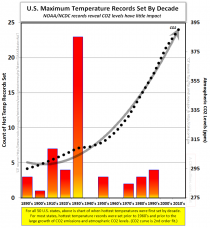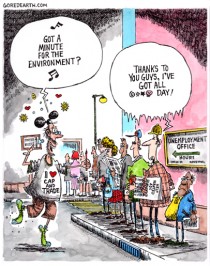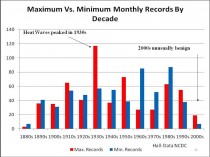Source: Business Green
Two Harvard engineers are planning to spray thousands of tonnes of sun-reflecting chemical particles into the atmosphere to artificially cool the planet, using a balloon flying 80,000 feet over Fort Sumner, New Mexico.
The field experiment in solar geoengineering aims to ultimately create a technology to replicate the observed effects of volcanoes that spew sulphates into the stratosphere, using sulphate aerosols to bounce sunlight back to space and decrease the temperature of the Earth.
David Keith, one of the investigators, has argued that solar geoengineering could be an inexpensive method to slow down global warming, but other scientists warn that it could have unpredictable, disastrous consequences for the Earth’s weather systems and food supplies. Environmental groups fear that the push to make geoengineering a “plan B” for climate change will undermine efforts to reduce carbon emissions.
Keith, who manages a multimillion dollar geoengineering research fund provided by Microsoft founder Bill Gates, previously commissioned a study by a US aerospace company that made the case for the feasibility of large-scale deployment of solar geoengineering technologies.
His US experiment, conducted with American James Anderson, will take place within a year and involve the release of tens or hundreds of kilograms of particles to measure the impacts on ozone chemistry, and to test ways to make sulphate aerosols the appropriate size. Since it is impossible to simulate the complexity of the stratosphere in a laboratory, Keith says the experiment will provide an opportunity to improve models of how the ozone layer could be altered by much larger-scale sulphate spraying.
“The objective is not to alter the climate, but simply to probe the processes at a micro scale,” said Keith. “The direct risk is very small.”
While the experiment may not harm the climate, environmental groups say that the global environmental risks of solar geoengineering have been amply identified through modelling and the study of the impacts of sulphuric dust emitted by volcanoes.
“Impacts include the potential for further damage to the ozone layer, and disruption of rainfall, particularly in tropical and subtropical regions - potentially threatening the food supplies of billions of people,” said Pat Mooney, executive director of the Canadian-based technology watchdog ETC Group. “It will do nothing to decrease levels of greenhouse gases in the atmosphere or halt ocean acidification. And solar geoengineering is likely to increase the risk of climate-related international conflict - given that the modelling to date shows it poses greater risks to the global south.”
A scientific study published last month concluded that solar radiation management could decrease rainfall by 15 per cent in areas of North America and northern Eurasia and by more than 20 per cent in central South America.
Last autumn, a British field test of a balloon-and-hosepipe device that would have pumped water into the sky generated controversy. The government-funded project - Stratospheric Particle Injection for Climate Engineering (Spice) - was cancelled after a row over patents and a public outcry by global NGOs, some of whom argued the project was a “Trojan horse” that would open the door to full-scale deployment of the technology.
Keith said he opposed Spice from the outset because it would not have improved knowledge of the risks or effectiveness of solar geoengineering, unlike his own experiment.
“I salute the British government for getting out and trying something,” he said. “But I wish they’d had a better process, because those opposed to any such experiments will see it as a victory and try to stop other experiments as well.”
The Guardian understands that Keith is planning to use the Gates-backed fund to organise a meeting to study the lessons of Spice.
C3 Headlines
The recent toasty 2012 summer weather experienced in the U.S. has the climate doomsday pundits again claiming that extreme global warming (EGW) is to blame - however, NOAA’s NCDC climate research agency has recently documented that EGW for the U.S. over the last decade was AWOL. (click images to enlarge)

Read here. The NCDC, a NOAA climate research unit, recently published a new dataset compiling U.S. weather records, including the maximum temperature record for each state. (Interestingly, the NCDC refers to these as ‘climate extremes’ - to the casual observer, it would be more accurate to refer to them as ‘weather extremes.’![]()
The adjacent chart shows when those maximum temperature records were initially set, by decade. In addition, the black dots represent the average CO2 level by decade. [Update 7/15/12: We were notified by ‘C3’ reader that chart had mistake, and we confirmed - the 1930’s had 24 maximum temperature records, not 23; the 1990’s actually had 3, not 4 as shown in the chart]
“It also is useful for putting the recent heat wave in perspective. Despite the 24/7 caterwauling, only two new state records - South Carolina and Georgia- are currently under investigation. And, looking carefully at Shein et al. dataset, there appears to be a remarkable lack of all-time records in recent years. This is particularly striking given the increasing urbanization of the U.S. and the consequent “non climatic” warming that creeps into previously pristine records. Everything else being equal-and with no warming from increased greenhouse gases- most statewide records should be in or near big cities. But they aren’t.”
Per NOAA, 82% of all maximum records were initially set prior to 1960 and prior to the accelerated growth of human CO2 emissions and atmospheric CO2 levels.
As can be seen, through 2011, no maximum temperature records have been set since the 1990’s. This is simply amazing since all the climate doomsday scientists and pundits have stated that recent global warming was “unprecedented” and that U.S. temperatures were rapidly increasing due to CO2 levels.
Based on the hysterical hyperbole from mainstream media sources, one would naturally have expected that many new maximum temperature records would have been set (not tied) since 1999.
Alas, it did not happen. Therefore, one can conclude that the U.S. was overdue for some record-setting temperatures and should be expected in the very near future.
As if on cue, the 2012 hot summer arrived in the U.S. and it’s highly likely some new state maximum temperature records were set. Again, this should not be a surprise since a hot summer was overdue. And it most certainly was not a result of high CO2 levels.
Objectively, if high CO2 levels are primarily responsible for record maximum temperatures, than the past U.S. records prior to 1960 fully refute that speculative hypothesis.
This next chart lists each U.S. state and when its maximum temperature record was initially set, and includes those years when it was tied.
It’s especially interesting to note that there was just one state, and a single year (2006), where a previous maximum temperature record was reached.
Additionally, during the Super El Nino of 1998, not a single maximum temperature record was broken or reached, which is incredibly mind-boggling when one considers the combination of an extreme ENSO phase with high CO2 levels.
Conclusions: Despite the incredible growth of CO2 levels since 1960, the vast majority of U.S. extreme global warming took place pre-1960. Based on NOAA historical observations and expectations, the U.S. was due for a summer of record-setting temperatures regardless of CO2 levels - the 2012 hot summer may indeed tie old records and set new ones. And finally, the 1890’s to 1930’s were decades of extreme heat in the U.S., with the majority of state maximum temperature records being set during that period - climate doomsday scientists have no believable theory to explain such extreme global warming with such low CO2 levels.
Icecap Note: This confirms the study by Bruce Hall using NCDC Monthly State Records (50 states times 12 months or 600 data points).
Christopher C. Horner, OpEd Contributor, The Washington Examiner
Not long ago, the American Tradition Institute initiated a transparency campaign using federal and state freedom of information laws to learn more about how taxpayer-funded academics use their positions to advance a particular agenda. On its face, this should have been welcomed by the Left, which often lays claim to the “transparency” mantle. It is instead causing great angst.
Our project would compile the context to the “Climategate” scandal, which, as activist academics central to its revelations assured us, was really an out-of-context misrepresentation. Curiously, the same people think this project a very bad idea.
So do the media and environmentalist establishments. Of the latter, the Union of Concerned Scientists became particularly exercised, mobilizing left-wing groups to urge universities not to satisfy our requests for public documents.
None of these groups, incidentally, was troubled by a series of similar requests by Greenpeace, whose effort we replicated. They only became opposed when we sought the emails of the sort of activists with whom they work.
Some of these, recently obtained from Texas A&M University, provide one explanation for this reversal.
For example, they reveal a sophisticated UCS operation to assist activist academics and other government employees as authorities for promoting UCS’s agenda. This includes “moot-courting” congressional hearings with a team of UCS staff, all the way down to providing dossiers on key committee members, addressing in particular their faith, stance on gay marriage and stimulus spending. Of course.
This also includes directing the taxpayers’ servants to outside PR consultants—apparently pro bono or else on UCS’s dime. Keep this last point in mind.
They also expose the New York Times reporter who covers the environment, science and specifically the global warming issue, Justin Gillis, as being no disinterested party. Gillis wrote a piece in May laboring to undermine one of the most highly credentialed and respected climate “skeptics,” the Massachusetts Institute of Technology’s Dr. Richard Lindzen. This front-page article prompted my request for information reflecting how the A&M professor and activist whom Gillis quoted was using his taxpayer-funded position.
The specific correspondence began when Gillis wrote that interviewing Lindzen for a piece on his area of expertise was “unavoidable,” and “[s]o I need a really good bibliography of all the published science” countering Lindzen’s position on cloud feedback—“that is, anything that stands as evidence against Lindzen’s claim that the feedback has to be strongly negative.”
Remember, this was a reporter for the New York Times writing this. In the released emails, Gillis comes off as an activist posing as a journalist, sneering at Lindzen. Of another prominent skeptic, Gillis wrote, “I sense you’ve got him in a trap here ... can’t wait to see it sprung.” (Ellipses in original.)
Our transparency campaign caused much wailing and gnashing of teeth among academia and its affiliated societies, the Washington Post, and the American Constitution Society. They joined UCS to attest that these sacrosanct exchanges of ideas would be fatally chilled if not granted an unlegislated exemption from freedom of information laws.
So you might be surprised to learn that the Texas A&M email production shows the academics actually forwarding their email discussions outside their circle. To New York Times reporters, for example. They even often copy reporters on the very exchanges they otherwise insist represent an intellectual circle that must remain free from violation by prying, nonacademic eyes.
Awkward.
Following my Texas A&M request, a producer contacted me from “Frontline,” a PBS program known for grinding liberal axes. She wanted to discuss our Freedom of Information Act litigation. As we are currently only involved in the high-profile case involving the University of Virginia’s Climategate records, I referred her to lead counsel.
It turns out she was really interested in records requests with two different, more cooperative schools: the Texas A&M request, and one I filed at Texas Tech University. The latter sought a professor and climate activist’s correspondence about a chapter she was writing for Newt Gingrich’s upcoming book. (Naturally, this Texas Tech professor who opposed providing me the emails had already provided them to a Los Angeles Times reporter.)
Now, you might ask, how would two otherwise fairly obscure Texas activists become the subject of interest to “Frontline”? That brings us back to UCS.
One of the emails produced by Texas A&M shows its activist contacting, and being given advice by, a D.C. media consultant, Richard Ades of Prism Public Affairs, “a strategic communications firm that operates at the intersection of public policy and the media” according to its website. The professor says he was referred by Aaron Huertas of UCS.
I have sent two other public records requests following up on these points. Expect the usual suspects to respond in their usual way. The media, academia and environmentalist pressure groups share an agenda, and work closely together to advance it. Remember this when these interests assail efforts to obtain public records shedding light on these activities.
Christopher C. Horner is director of litigation for the American Tradition Institute and author of the forthcoming book “The Liberal War on Transparency: Confessions of a Freedom of Information ‘Criminal’ “ (Threshold).




